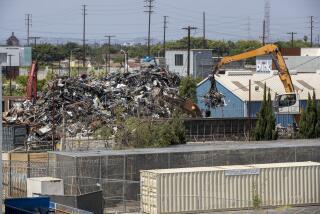Mine waste that fouled river isn’t the only such sludge hidden in Colorado mountains

Melanie Bergolc walks along the banks of Cement Creek in Silverton, Colo., on Aug. 10. The area is a few miles downstream from the Gold King Mine.
The San Juan Mountains’ towering peaks poured gold and silver into the cities of the valley below, but nothing in this high, rugged country comes without a price.
The Environmental Protection Agency and a slate of state and local players have worried for decades about the poisonous waste and polluted water bequeathed by the rich mining history.
Locals thought the problem had been solved by pushing the toxic water back into the mountain. But then the mountain pushed back.
------------
FOR THE RECORD:
Colorado mine spill: In the Aug. 18 Section A, an article about the spill of toxic water from the Gold King mine into the Animas River implied that Standard Metal had sold a neighboring mine, the Sunnyside, before it was closed in 1991. The mine was sold in 2003, 12 years after its closure.
------------
On Monday, the EPA’s Office of Inspector General announced it would investigate the Aug. 5 spill and the agency’s response. An EPA exploratory cleaning team narrowly escaped a 20-foot-high wall of orange water that coursed out of the Gold King Mine on Bonita Peak, about 12 miles north of Silverton.
NEWSLETTER: Get the day’s top headlines from Times Editor Davan Maharaj >>
Three million gallons of water laden with cadmium, lead and arsenic poured into tiny Cement Creek and from there into the Animas River, where Colorado and New Mexico officials cautioned people to stay out of the water and temporarily cut off irrigation to farms before restoring some use last week.
It is not the only source of pollution here. A series of other closed mines continues to pour 540 to 740 gallons of acid drainage per minute into Animas headwaters.
Who is to blame? The mining companies? The regulators who allowed the companies to plug a drainage ditch and let the water accumulate inside the mountain? Or the citizens of Silverton, who battled an EPA Superfund designation for more than 20 years?
No one can say for sure, but one thing is clear: The Gold King spill was years in the making.
“What’s the original sin? Plugging that mine, then letting that water sit and letting the companies get away with it,” said Mitchell Gillon, 30, who worked the mines for three years. “The EPA didn’t make them fix it, and they’re not going to do it on their own.”
The mines’ history is complicated, and any interconnectedness a mystery. With the flooding, no one can say with certainty whether one mine is connected to another and, if so, whose polluted water came out of Gold King.
Lithe and sinewy despite a months-long layoff from mine work, Gillon flicks a cigarette into Cement Creek without thinking, curses loudly and produces a pocketful of menthol cigarette butts to prove he is no litterbug.
“We love the place we live,” he said, peppering his comments with a colorful combination of expletives delivered in a slight drawl.
“I want my kids, when I have them, to scratch their knees and bump their elbows here,” he said. “We don’t want this city gone. But we need mining back, responsible mining that won’t dump metals like they did” in the 1890s.
Gold King closed in the 1920s, but another mine, the Sunnyside, was believed to have access to the same vein. To reach it, Standard Metal in 1959 drilled a massive pipe into the mountain, aiming to tap the vein of gold from underneath.
The so-called American Tunnel collected water from Sunnyside mine, and possibly from other mines, and dumped the toxic tailings into Cement Creek.
Then in 1972, the U.S. revised the Clean Water Act and the mine’s wastewater became an expensive problem for Standard Metal. The company needed discharge permits and a treatment plant for the polluted water.
------------
FOR THE RECORD: In the Aug. 18 Section A, an article about the spill of toxic water from the Gold King mine into the Animas River implied that Standard Metal had sold a neighboring mine, the Sunnyside, before it was closed in 1991. The mine was sold in 2003, 12 years after its closure.
------------
Standard Metal sold the mine and its pricey water treatment problem to a group that named itself Sunnyside Gold Corp., a subsidiary of Canadian mining giant Kinross Gold. The state of Colorado insisted that Sunnyside Gold contain or treat the seepages coming out of the mine.
The company closed the Sunnyside mine in 1991, but the mine tailings remained. Company officials’ solution was to seal the hole with a concrete plug the size of a railway car. A similar plug was used at Gold King.
For decades, that was that. Polluted water continued to pool and seep out of the mine, but not from the American Tunnel. Facing yet more fines, the company struck a deal with the state in the form of a consent decree: The mine would continue to drip toxic metals into the water, but Sunnyside Gold would do multimillion-dollar reclamation projects downstream.
At the time, this was considered a success story in dealing with the EPA, which investigated the area as a potential Superfund site.
But Silverton is a tourist town now. So locals and the mining companies joined forces as the Animas River Stakeholders Group, seeking to avoid a Superfund stigma.
The Superfund program uses taxpayer money to clean up environmental messes but is a shell of its former self. The fund used to be supported by penalties assessed on chemical and petroleum companies, but Congress let that funding source lapse in 1995. The Superfund program announced it was out of financial reserves in 2003.
“We didn’t want a Superfund because it is not super funded,” said Bill Simon, co-founder of the Animas River Stakeholders Group.
Now, the owners of Gold King and Sunnyside are pointing fingers at each other and blaming the EPA.
“Kinross Gold Corp. [owner of the Sunnyside] is a rogue mining company,” said Todd Hennis, who owns the Gold King Mine and blames Sunnyside for the accumulation of water.
“I believe Sunnyside knew it was going to happen and they stalled any action because it will cost them money to fix it,” Hennis said.
Kinross categorically denied that Sunnyside had any involvement in the spill.
“The representative of Gold King mine is making unsubstantiated, baseless and irresponsible allegations,” Kinross said in response to emailed questions from the Los Angeles Times. “To reiterate, while the state-approved [plug] Sunnyside completed was always expected to return the local water table towards historic natural levels, it did not cause the water buildup at Gold King.”
Without going into the flooded mine, EPA regulators and mine experts say, it’s impossible to know whether cracks, fissures, fractures, geological faults or even exploratory drill holes after World War II could have connected the mines.
Since the spill, locals have complained that the EPA ignored warnings about toxic mine water and responded to questions with vague or nonexistent answers.
In a conference call with reporters last week, EPA Area Commander David Ostrander said the Sunnyside and Gold King mines “may have some connections back and forth.” When asked later by email to clarify whether he believed such connections were possible, he replied, “We aren’t going to comment on this.”
ALSO:
Young immigrants placed in sponsor homes are at risk of abuse, experts say
As immigration backlog surges, some overwhelmed judges retire
U.S. wildfires scorch land at dramatic rate, but then there’s the Alaska factor
More to Read
Start your day right
Sign up for Essential California for news, features and recommendations from the L.A. Times and beyond in your inbox six days a week.
You may occasionally receive promotional content from the Los Angeles Times.







